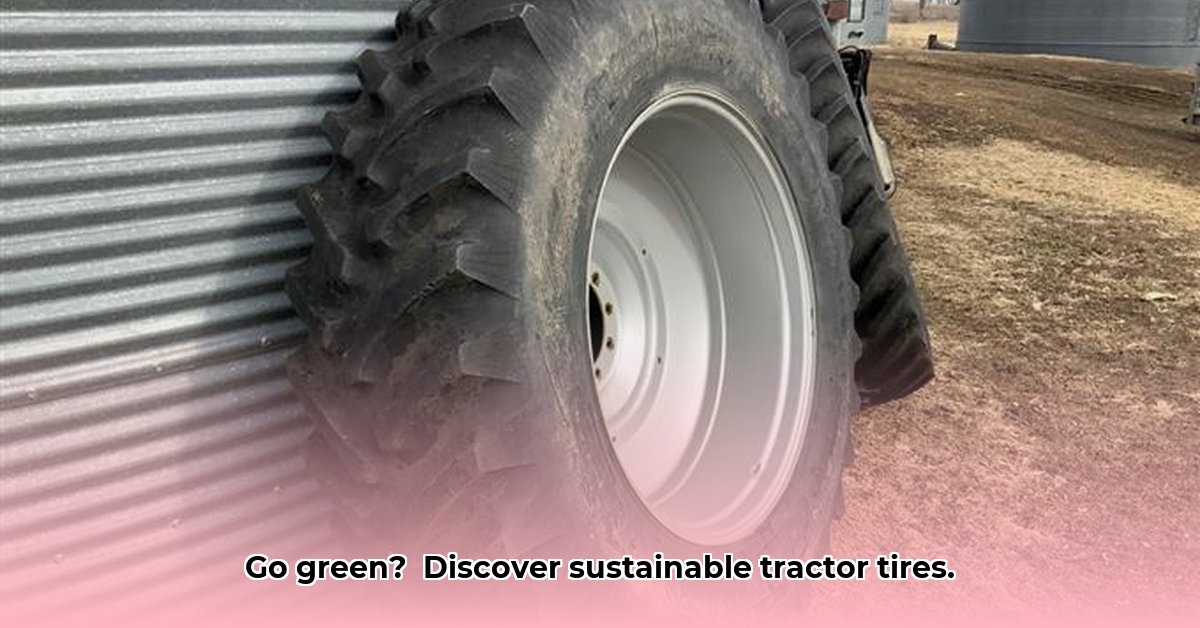
20.8R42 Tractor Tires: Assessing Sustainability in Large-Scale Agriculture
The 20.8R42 tractor tire, a mainstay in modern large-scale farming, presents a complex sustainability challenge. While essential for efficient agricultural operations, their environmental impact across their lifecycle—from material extraction to disposal—requires thorough investigation. This report analyzes the current state of knowledge concerning the sustainability of these tires, identifies critical knowledge gaps, and proposes avenues for future research and collaborative action. For additional tire size information, see this helpful conversion chart.
Understanding the Data Landscape: Current Knowledge and Limitations
While the prevalence of 20.8R42 tires in online marketplaces like TractorHouse indicates significant demand within the agricultural sector, crucial data remain elusive. Current information lacks sufficient detail to comprehensively assess their long-term durability, fuel efficiency impact, and end-of-life management practices. This limited data significantly hampers a thorough evaluation of their overall environmental footprint. How long do these tires typically last in real-world agricultural settings? Do they demonstrably improve or reduce fuel efficiency compared to alternatives? What are the prevalent disposal or recycling methods, and what is their efficacy? These questions remain largely unanswered.
Environmental Footprint: A Holistic Lifecycle Perspective
Assessing the sustainability of 20.8R42 tires demands a complete life cycle assessment (LCA). This requires detailed information on:
- Material Sourcing: What materials are used in tire manufacturing, and what are their environmental impacts? Are they sourced sustainably? Are there opportunities for using recycled or renewable materials?
- Manufacturing Processes: What is the energy consumption associated with tire production? What are the associated greenhouse gas emissions? Are there opportunities for reducing energy consumption and emissions?
- Operational Use: What is the tire's impact on soil compaction, fuel efficiency, and greenhouse gas emissions throughout its operational lifespan?
- End-of-Life Management: What happens to these tires at the end of their service life? What are the options for recycling, retreading, or responsible disposal? What is the environmental impact of each method?
Currently, comprehensive data addressing these crucial aspects are lacking, hindering a robust and conclusive assessment of the overall environmental footprint.
Soil Compaction and Agricultural Practices: A Balancing Act
The large size and weight of 20.8R42 tires raise concerns about potential soil compaction. While offering superior traction and load-bearing capacity, excessive compaction can negatively impact soil health, water infiltration, and ultimately, crop yields. The optimal tire pressure for minimizing compaction while maximizing performance remains an area requiring further investigation, alongside research into alternative tire designs that minimize soil disturbance. Are there tire designs and operating pressures that minimize compaction without compromising performance? This demands rigorous field testing across diverse soil types and farming conditions.
Pathways to Greener Agriculture: Collaborative Action Plan
Addressing the sustainability challenges associated with 20.8R42 tires necessitates a collaborative approach involving multiple stakeholders:
Tire Manufacturers: Increased transparency regarding tire composition, manufacturing processes, and end-of-life management strategies is crucial. Investment in research and development of sustainable materials (e.g., bio-based materials, recycled rubber) and innovative tire designs that minimize soil compaction are essential. Robust recycling programs are also needed.
Farmers and Agricultural Businesses: Data-driven decision-making regarding fuel efficiency and soil compaction is vital. Exploring leasing models for tires can improve responsible disposal and reduce upfront costs. Adopting precision farming techniques to optimize routes and reduce passes can minimize soil disturbance. Active advocacy for policies promoting sustainable practices is also beneficial.
Governments and Regulators: Funding research on comprehensive LCAs and standardized testing of agricultural tires is crucial for objective comparisons. Regulations governing tire composition, disposal, and recycling can provide significant incentives for sustainable practices.
Researchers and Academics: Conducting comprehensive LCAs, developing standardized testing protocols, and advancing soil compaction models can significantly improve our understanding of the sustainability challenges and potential solutions.
Key Takeaways: The Path Forward
- Data Gaps Exist: Comprehensive data on the lifespan, fuel efficiency, and end-of-life management of 20.8R42 tires are critically lacking.
- Collaboration is Key: Addressing the sustainability of these tires requires a collaborative effort amongst manufacturers, farmers, researchers, and regulators.
- Research is Essential: Further research into sustainable materials, optimized tire designs, and responsible disposal methods is imperative.
This report emphasizes the urgent need for data-driven analysis to comprehensively evaluate the environmental footprint of 20.8R42 tires. Only through collaborative research and transparent data sharing can the agricultural sector transition towards truly sustainable practices.